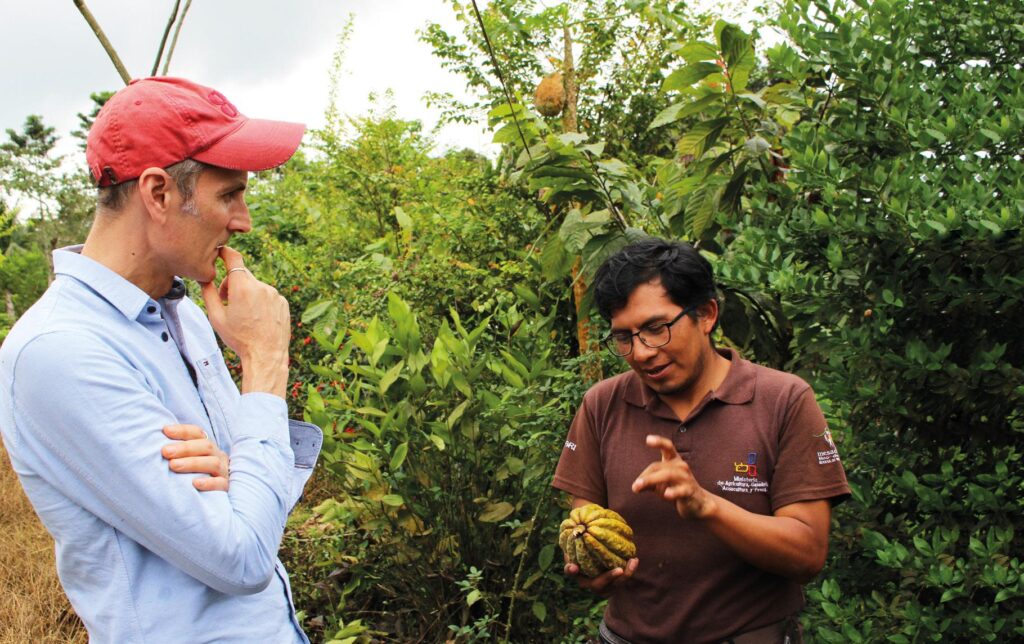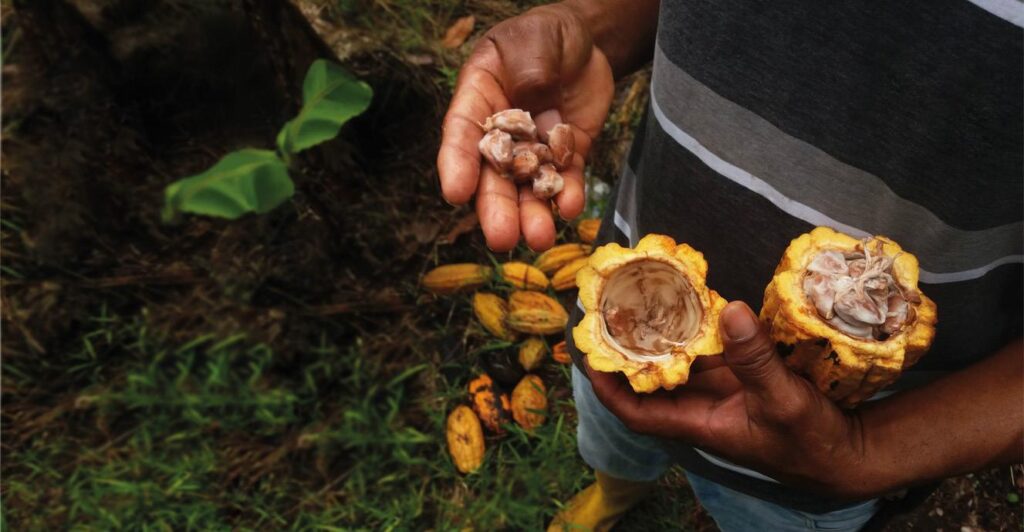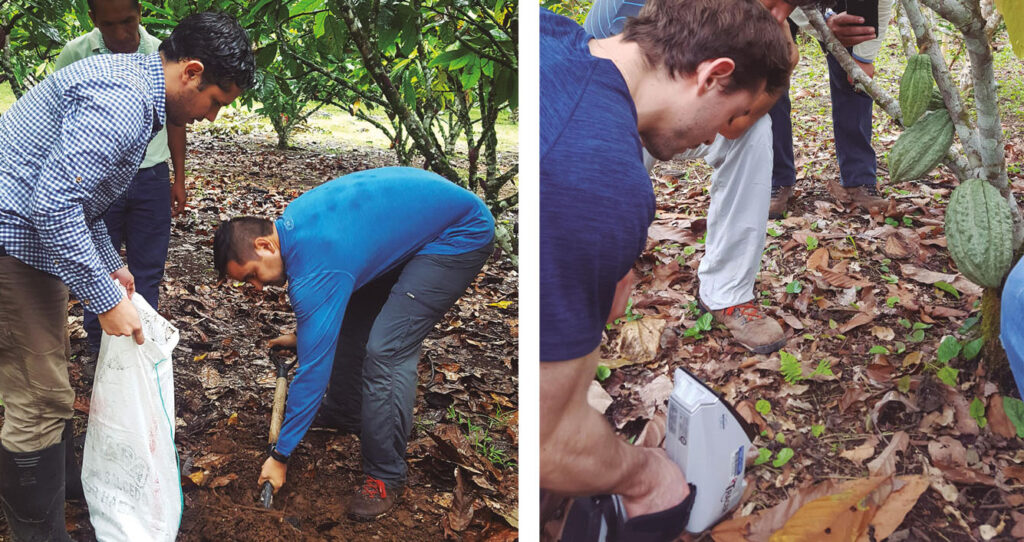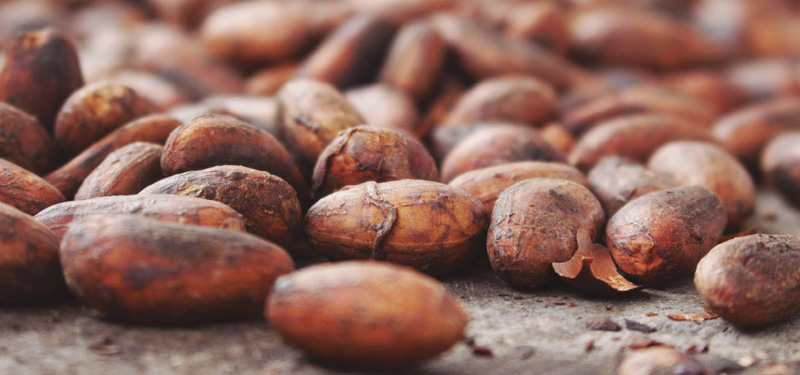Cadmium is a heavy metal with a blue hue, closely associated with zinc. In the Andean region, Ecuador is leading the charge in the mitigation of cadmium in cacao crops due to a national multi-stakeholder research and dissemination agenda. In this field, Rikolto and MOCCA support research to ensure product access to European markets. Access all the tools created based on Rikolto and MOCCA support research in 2021 here.
The alerts were triggered in 2014 after the European Union (EU) announced its intention to regulate maximum cadmium (Cd) levels for products such as cacao and its derivatives. The entry restrictions for the product were intended to prevent health problems in consumers and the environment.
The Ecuadorian government, capitalizing on years of research promoted by the chain’s stakeholders, with the support of the PROGRAM “Maximizing Opportunities for Coffee and Cacao in the Americas” (MOCCA), published a toolbox in 2021 with 13 guidelines for the mitigation of cadmium in crops. The result, validated with international experts, will help “cacao arriba” (denomination of origin for fine aroma cacao) maintain its prestige in one of its main markets.
Learn how MOCCA and Rikolto in Ecuador promote research and tools that guarantee quality standards in the chain.

Cadmium research on the agenda
As soon as the EU’s bets became known, the country in the south got to work. Regulation 488/2014 stipulated that by 2019 any cacao product whose cadmium levels exceeded indicated limits would be refused entry to countries such as Germany, Belgium, the Netherlands, and France.
Thus, from 2017 to 2018, several working groups were held with public and private actors of the chain, including non-governmental organizations such as Rikolto. In these spaces, research on the causes of cadmium in the soil was one of the pillars for articulation. Eventually, it was integrated as one of the pillars of Ecuador’s National Cadmium Agenda, which is part of the chain’s Competitive Improvement Plan.
To date, MOCCA is progressing in the implementation of the plan and the consolidation of comparative studies on the subject at the regional level. Thanks to the program, new topics have been identified for the research agenda, such as the level of cadmium absorption in cacao clones.

Leading the cadmium research
Numerous research was undertaken prior to the plan, to understand the cadmium landscape in the territory. From 2017 to 2019 the Escuela Superior Politécnica del Litoral (Espol) and the Ministry of Agriculture and Livestock (MAG) with the support of organizations such as Rikolto, developed nationwide studies on cadmium absorption. The purpose was to create a national map of the levels of cadmium in the crop that could serve as a basis for mitigation pilots through fertilization. Several of the recommendations and current mitigation strategies derive from the application of amendments such as limescale and charcoal.
These research efforts positioned the country. As stated by Eduardo Chávez, a researcher and Director of Fontagro, MOCCA’s regional partner program: “Ecuador is a country where cadmium research has advanced considerably. We have demonstration farms where mitigation tasks are being executed (…) where we are already achieving very encouraging results for farmers. This has only been done in Ecuador”.

The scientist adds that research should be tracked towards the maintenance of these farms. This will better assess the effect of these mitigation actions over time and give farmers recommendations based on robust data. Another possible turn of research is to target the identification of cadmium resistant varieties.
Dissemination and tools for the continent
The MOCCA Program has been contributing to the dissemination of findings from various research studies on cadmium in cacao since 2019, in order to provide new data to farmers and technicians, and pour the recommendations in workshops, forums with experts and, most recently, in a toolbox with 13 guides. The latter consolidates the main information available in the country and regionally.
The information in these guides is intended for use by farmers, consultants, specialists, and researchers among other actors in the cacao chain.
“There has been a common vision about the need to systematize and disseminate existing knowledge and good practices,” says Pedro Ramirez, advisor to the GIZ/EU-CEFA project.
“This contributes to the dissemination of methodologies and best practices in two topics: metal reduction mechanisms in the soil and clone selection techniques that reduce high levels of cadmium,” comments José Luis Cueva, MOCCA Ecuador Manager and member of the Rikolto team.
Andrés Proaño, from MAG’s Coffee and Cacao Reactivation Project, adds that “the guidelines prepared in partnership with MOCCA will allow us to standardize the language and actions in Ecuador and the region to address the problem”.
To date, more than 600 farmers and promoters in Latin America have participated in forums on cadmium that were organized in Ecuador, Peru, Colombia, and Nicaragua, among other countries. The events were based on the toolbox guidelines.
MOCCA is an initiative led by TechnoServe and Lutheran World Relief, funded by USDA. In Ecuador it is implemented in partnership with Rikolto.
Download guidelines here. https://bit.ly/3nreRny

Training cycle on cadmium
During the first semester of 2021, MOCCA organized a series of regional forums on cadmium mitigation for Latin American cacao farmers and technicians, in partnership with the European Union, GIZ, CEFA-Onlus and the facilitation of the Ministry of Agriculture and Livestock of Ecuador.
Impact of EU cadmium regulations on the Ecuadorian cacao industry, by José Luis Vásquez (ESPOL-Ecuador). Cadmium bioaccumulation in cacao: sources, control factors, mobilization and management of cadmium in soil, plants and beans, by Laurence Maurice (Ethiquable-France). Practical experiences to prevent and reduce cadmium contamination in cacao, by Laudine Marchive (Ethiquable-France).
View the recording here: https://fb.watch/v/13bc4b2CU/
Selection of productive and low cadmium absorption in cacao clones/varieties in Peru, by César Arévalo (ICT-Peru). Agronomic strategies to reduce cadmium levels in cacao: practical considerations for farmers, by Eduardo Chavez (ESPOL-Ecuador). Use of organic and mineral amendments for cadmium mitigation in cacao soils, by Manuel Carrillo (INIAP-Ecuador).
View the recording here:https://fb.watch/v/19mq1U4eb/
Mechanisms to reduce cadmium levels in soils using microorganisms, by Fabricio Canchignia (UTEQ-Ecuador). Characteristics and soil conditions for the growth of microorganisms that reduce cadmium absorption and criteria for selection of bioformulates, by Daniel Bravo (AGROSAVIA-Colombia). Can cadmium levels be reduced in commercial lots using physical mixtures?, by Eduardo Chavez (ESPOL-Ecuador).
View the recording here: https://fb.watch/v/3aYJeGx7q/







